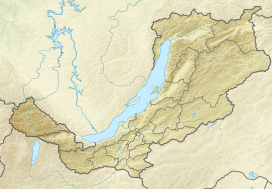
Peridotite ( PERR-ih-doh-tyte, pə-RID-ə-) is a dense, coarse-grained igneous rock consisting mostly of the silicate minerals olivine and pyroxene. Peridotite is ultramafic, as the rock contains less than 45% silica. It is high in magnesium (Mg2+), reflecting the high proportions of magnesium-rich olivine, with appreciable iron. Peridotite is derived from Earth's mantle, either as solid blocks and fragments, or as crystals accumulated from magmas that formed in the mantle. The compositions of peridotites from these layered igneous complexes vary widely, reflecting the relative proportions of pyroxenes, chromite, plagioclase, and amphibole.

The Northern Cordilleran Volcanic Province (NCVP), formerly known as the Stikine Volcanic Belt, is a geologic province defined by the occurrence of Miocene to Holocene volcanoes in the Pacific Northwest of North America. This belt of volcanoes extends roughly north-northwest from northwestern British Columbia and the Alaska Panhandle through Yukon to the Southeast Fairbanks Census Area of far eastern Alaska, in a corridor hundreds of kilometres wide. It is the most recently defined volcanic province in the Western Cordillera. It has formed due to extensional cracking of the North American continent—similar to other on-land extensional volcanic zones, including the Basin and Range Province and the East African Rift. Although taking its name from the Western Cordillera, this term is a geologic grouping rather than a geographic one. The southmost part of the NCVP has more, and larger, volcanoes than does the rest of the NCVP; further north it is less clearly delineated, describing a large arch that sways westward through central Yukon.
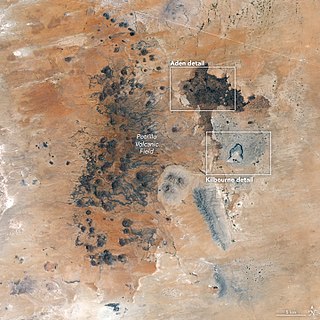
The Potrillo volcanic field is a monogenetic volcanic field located on the Rio Grande Rift in southern New Mexico, United States and northern Chihuahua, Mexico. The volcanic field lies 22 miles (35 km) southwest of Las Cruces, and occupies about 4,600 square kilometers (1,800 sq mi) near the U.S. border with Mexico.
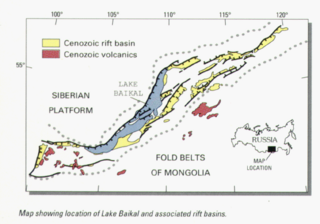
The Baikal Rift Zone is a series of continental rifts centered beneath Lake Baikal in southeastern Russia. Current strain in the rifts tends to be extending with some shear movement. A series of basins form along the zone for more than 2,000 kilometres (1,200 mi), creating a rift valley. The rifts form between the Eurasian Plate to the west and the Amur Plate to the east.

The San Quintín Volcanic Field is a collection of ten or eleven volcanic cinder cones situated along the Pacific coast of the Baja California peninsula in Mexico. The field formed by repeated eruptions beginning in the Pleistocene and ending about 3000 years ago. It is one of several known Quaternary period volcanic fields in Baja. The lava shields appear to have first grown as subaqueous volcanoes that emerged as islands.
The Igwisi Hills are a volcanic field in Kaliua District of Tabora Region of Tanzania. Three tuff cones are found there, one of which is associated with a lava flow. They are one of the few locations of possibly kimberlitic lava flows on Earth.

The Udokan Plateau is a volcanic field in Transbaikalia, Russia. It covers a surface area of 3,000 square kilometres (1,200 sq mi) northeast of Lake Baikal in North Asia. Volcanism in the Udokan Plateau included both basaltic lava flows and later individual volcanic cones. Volcanism commenced in the Miocene and continued on into the Holocene.

Jom-Bolok, also known as Volcano Valley and East Sayan Volcanic Field, is a volcanic field in Russia, 200 kilometres (120 mi) west of Lake Baikal. It is part of the Baikal rift zone which is also responsible for volcanism elsewhere around Lake Baikal. The volcanic activity has generated long lava flows and cinder cones. One of the lava flows is 70 kilometres (43 mi) long and has a volume of 7.9 cubic kilometres (1.9 cu mi).
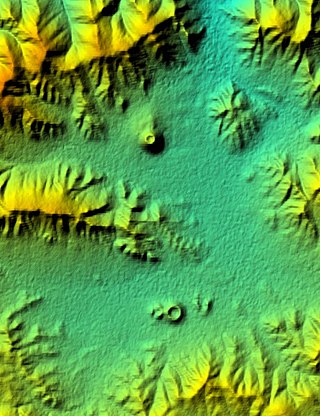
Khanuy-Gol is a volcanic field in Mongolia. Khanuy-Gol is located in the northern Hangai range, north of the settlement of Bulgan.
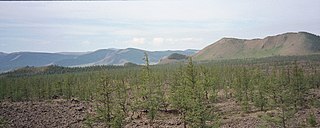
Taryatu-Chulutu is a volcanic field in Mongolia. It is part of a volcanic area in Central Asia in the Hangai range that may be linked to the rifting of the Lake Baikal Rift. The field itself is located within the valleys of the Chuluut and Suman rivers. Volcanic activity occurred in the Miocene, Pliocene, Pleistocene and Holocene. The Khorgo cinder cone erupted during the Holocene and lava flows from it formed a lava dam generating Terkhiin Tsagaan Nuur lake.
Joanne S. Johnson is a geologist and Antarctic scientist, who has worked for British Antarctic Survey (BAS) since 2002. She works in the palaeoenvironments, ice sheets and climate change team and is best known for her work on glacial retreat. The Johnson Mesa in James Ross Island, Antarctica is named in her honour.
Azas Plateau is a volcanic field in Russia. It is also known as East Tuva Plateau, Khamsara-Biykhem Plateau and Northeast Tuva Plateau. It covers a surface area of 2,000 square kilometres (770 sq mi) west of Lake Baikal. Volcanic activity in the area also occurred at the Oka Plateau and the Jom-Bolok volcanic field.

The Pali-Aike volcanic field is a volcanic field along the Argentina–Chile border. It is part of a family of back-arc volcanoes in Patagonia, which formed from processes involving the collision of the Chile Ridge with the Peru–Chile Trench. It lies farther east than the Austral Volcanic Zone, the volcanic arc that makes up the Andean Volcanic Belt at this latitude. Pali-Aike formed over sedimentary rock of Magallanes Basin, a Jurassic-age basin starting from the late Miocene as a consequence of regional tectonic events.
Cerro de los Chenques is a monogenetic volcano in the Chubut Province, Argentina, which was considered to be of Holocene age but was later re-dated to be of lower Pleistocene age. The volcano developed on a basement formed by Mesoproterozoic and Neoproterozoic rocks and more recent volcanic and granitic formations.

Big Pine volcanic field is a volcanic field in Inyo County, California. The volcanic field covers a surface area of 500 square kilometres (190 sq mi) within the Owens Valley east of the Sierra Nevada and consists of lava flows, one rhyolitic coulee and about 40 volcanic vents including cinder cones. Some vents are simple conical cinder cones while others are irregular scoria cones. Glaciers and former lakes have modified lava flows.

Noronha hotspot is a hypothesized hotspot in the Atlantic Ocean. It has been proposed as the candidate source for volcanism in the Fernando de Noronha archipelago of Brazil, as well as of other volcanoes also in Brazil and even the Bahamas and the Central Atlantic Magmatic Province.
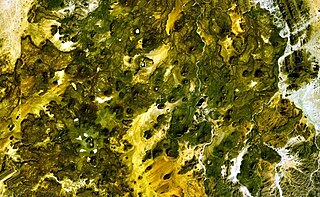
Manzaz volcanic field is a volcanic field in Algeria. It consists of scoria cones with lava flows and has been active until recently.
In Teria volcanic field is a volcanic field in Algeria. It consists of about 20 craters.
Gharyan volcanic field is a volcanic field in northwestern Libya, with the towns of Bani Walid, Gharyan, Mizdah and Tarhunah close by.

The Navajo volcanic field is a monogenetic volcanic field located in the Four Corners region of the United States, in the central part of the Colorado Plateau. The volcanic field consists of over 80 volcanoes and associated intrusions of unusual potassium-rich compositions, with an age range of 26.2 to 24.7 million years (Ma).


